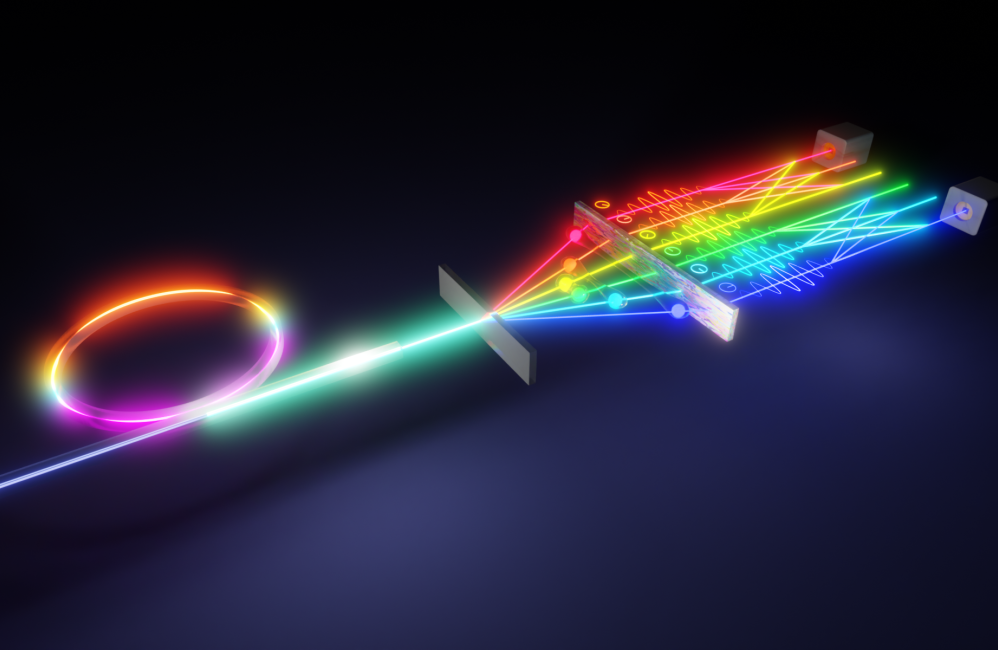A groundbreaking development in quantum computing has emerged as researchers successfully created a method to measure complex quantum states called qudits using quantum frequency combs on a single optical chip. This advance represents a significant step forward in quantum information processing and communication.
To understand the significance, it’s helpful to compare qudits to their more familiar counterpart, qubits. While classical computers use bits that can be either 0 or 1, qubits can exist in multiple states simultaneously due to quantum superposition. Qudits take this a step further by encoding even more levels of information, making them potentially more powerful for quantum computing applications. They also show greater resistance to noise, which is crucial for developing robust quantum networks and communication systems.
The research team, comprising scientists from Oak Ridge National Laboratory, Purdue University, and the Swiss Federal Institute of Technology Lausanne (EPFL), achieved a remarkable milestone by characterizing entangled pairs of eight-level qudits. This created a 64-dimensional quantum space, quadrupling previous records for discrete frequency modes.
The experimental setup centered around a micro-ring resonator, an incredibly compact device measuring just one square millimeter. This chip-based photon source generated quantum frequency combs, which were then manipulated using telecommunications industry standard equipment – specifically, an electro-optic phase modulator and a pulse shaper. These tools allowed researchers to mix and modify different frequencies of light, capturing various frequency correlations.
A particularly innovative aspect of their approach was the measurement technique. Rather than constructing traditional quantum gates, the team employed a randomized measurement strategy, analogous to rolling entangled dice and recording the outcomes. To interpret these measurements, they developed a sophisticated data analysis tool based on Bayesian inference, running computer simulations to reconstruct the quantum states.
Dr. Hsuan-Hao Lu, a postdoctoral researcher at ORNL, emphasized the significance of their measurement technique, noting that while encoding high-level qudits using photon colors was known to be possible, measuring them had been a persistent challenge. The team’s new method provides an efficient and relatively straightforward experimental approach to this problem.
The research has immediate practical implications for quantum communication. The frequency-bin pairs used in this work are particularly well-suited for quantum information transfer, as they can travel through optical fiber while maintaining their quantum properties. This makes them promising candidates for quantum network applications.
Looking ahead, the research team is planning to conduct further experiments testing quantum communication protocols, including quantum teleportation and entanglement swapping. These tests will be performed using optical fiber networks, with plans to integrate the micro-ring resonator into ORNL’s quantum local area network.
This advance represents a significant step toward realizing practical quantum communication systems and, eventually, a quantum internet. The combination of high-dimensional quantum states, efficient measurement techniques, and compatibility with existing telecommunications infrastructure makes this approach particularly promising for real-world applications.
The research success stemmed from combining multiple cutting-edge technologies: state-of-the-art frequency-bin production, advanced light sources, and precise measurement techniques. This integration of various quantum technologies demonstrates how collaborative, multi-institutional research can drive progress in quantum computing and communication.
The results of this research were published in Nature Communications, marking a significant milestone in the field of quantum information science and bringing us closer to practical quantum communication networks.
Reference: Hsuan-Hao Lu, Karthik V. Myilswamy, Ryan S. Bennink, Suparna Seshadri, Mohammed S. Alshaykh, Junqiu Liu, Tobias J. Kippenberg, Daniel E. Leaird, Andrew M. Weiner, Joseph M. Lukens. Bayesian tomography of high-dimensional on-chip biphoton frequency combs with randomized measurements. Nature Communications, 2022; 13 (1) DOI: 10.1038/s41467-022-31639-z


